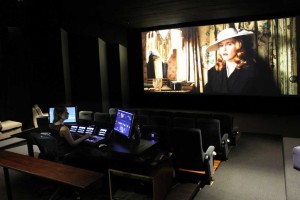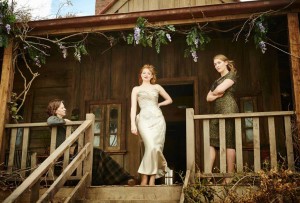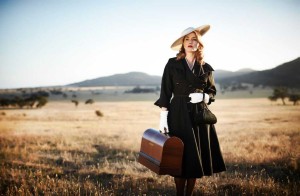 Australian postproduction facility Soundfirm recently relied on DaVinci Resolve Studio to grade Trish Cahill’s The Dressmaker.
Australian postproduction facility Soundfirm recently relied on DaVinci Resolve Studio to grade Trish Cahill’s The Dressmaker.
Based on the book by Rosalie Ham, The Dressmaker takes place in the 1950s and follows Myrtle ‘Tilly’ Dunnage (Kate Winslet) as she returns to her hometown to take care of her ill mother, Molly (Judy Davis), from whom she was sent away at the age of 10 because of false accusations of murder. Tilly, an expert dressmaker, transforms the locals with her couture creations and in the process, exacts revenge on the people who wrongly accused her of murder all those years ago. The film is produced by Sue Maslin, directed by Jocelyn Moorhouse and also stars Liam Hemsworth, Hugo Weaving and Sarah Snook.
“I made the decision to take The Dressmaker to Soundfirm as it is a one-stop shop for state-of-the-art sound and picture postproduction and enabled us to work with a world-class team of professionals who cared deeply about the story,” said Maslin. “I couldn’t be happier with the creative results that Resolve delivered in the hands of Don McAlpine and Cahill.”
According to Cahill, the look of the film needed to be true to the dry Australian landscape in which it is set, but it also needed to remain rich and beautiful. “McAlpine is a master cinematographer, so the film came to me with wonderful meat and bones already,” she said. “After the initial balance was in place, we looked for little things to enhance each frame, such as a chop at the top of frame here or an extra bit of sunshine on a patch of grass there.
 “We had the opportunity to experiment a little with the memory scenes where Tilly remembers moments from her childhood, which needed to look different from the present. We ended up with a moody contrast look with a desaturated, ashy palette. Wherever we had skies and silhouette trees we graded, keyed and dropped the mids. There was definitely a focus on the environment.”
“We had the opportunity to experiment a little with the memory scenes where Tilly remembers moments from her childhood, which needed to look different from the present. We ended up with a moody contrast look with a desaturated, ashy palette. Wherever we had skies and silhouette trees we graded, keyed and dropped the mids. There was definitely a focus on the environment.”
In one day-for-night shot, the camera was on a dolly moving towards a silo, and Cahill was tasked with retaining this camera movement while creating a starry nighttime sky. “It fell into place very quickly using Resolve’s superfast tracker for grades and the intuitive keyer to control the various areas of the image,” she explained. “The next shot is of the two main characters gazing up at the stars and talking about the night sky, and the shot needed stars. I made numerous one-pixel windows with a slight blur and lots of brightness and started moving them all over the place, occasionally making some brighter than others to recreate the randomness of a starry sky. The consensus in the room judging on a still frame was that it worked well.”
However, once the scene was played back, the stars needed more integration into the shot as the camera dollied forward. “Luckily for us, Resolve’s shape tracker and stabilizing tools are fantastic, so one run through at realtime with default settings on the stabilizer tool and bam! DaVinci Resolve made the stars sit perfectly into the night sky without any loss of our wonderful dolly effect,” said Cahill.
 DaVinci Resolve Studio’s tracker also proved beneficial when protecting the performances and subtlety of the actors’ eyes and faces while maintaining the rich and tonal look for the film. “We have gorgeous actors with beautiful blue eyes, which were sometimes a challenge to maintain in warmly lit scenes,” Cahill said. “This is where Resolve’s tracker also came in handy. To be able to go through the film and highlight the moments and selective colors we needed and yet keep the frame rich, vivid and inviting on a whole was a case of having our cake and eating it too.”
DaVinci Resolve Studio’s tracker also proved beneficial when protecting the performances and subtlety of the actors’ eyes and faces while maintaining the rich and tonal look for the film. “We have gorgeous actors with beautiful blue eyes, which were sometimes a challenge to maintain in warmly lit scenes,” Cahill said. “This is where Resolve’s tracker also came in handy. To be able to go through the film and highlight the moments and selective colors we needed and yet keep the frame rich, vivid and inviting on a whole was a case of having our cake and eating it too.”
DaVinci Resolve Studio was also used for the online edit of the film at Soundfirm, which has a number of Resolve Studio suites in both its Melbourne and Sydney facilities. “The flexibility of the system really allowed for it to form the backbone of the DI post workflow,” said Jonathan Burton, digital imaging supervisor at Soundfirm, “especially given that the production wanted to retain the 4K RAW files all the way to the final mastering of the film.”
“Resolve was used as the primary conform tool at Soundfirm Melbourne where the offline edit of the film was also done,” Burton explained. “There is a big advantage in being able to conform the film as the edit progresses, allowing the production to go between the online and offline versions of the cut and ultimately reflect any minor edit tweaks until the final picture lock off. Resolve was next used to handle all of the VFX I/O, creating deliveries to go to the VFX team along with temp grades, reviews and returns of VFX finals to go back into the online.
 “The final conformed Resolve projects were then sent up to our grading theatre at Fox Studios in Sydney, and DaVinci Resolve’s Consolidate Clips tool was used to move all the media and manage the transition between facilities.”
“The final conformed Resolve projects were then sent up to our grading theatre at Fox Studios in Sydney, and DaVinci Resolve’s Consolidate Clips tool was used to move all the media and manage the transition between facilities.”
“Overall I would say the biggest benefit is the flexibility of the system. Purely as a grading tool Resolve is fantastic and a top choice by colorists the world over, but from the point of view of a post house, the ability to use the same system across multiple facilities for everything in the DI path is a powerful asset.”





